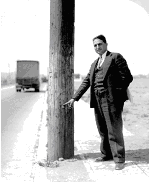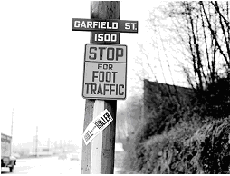
A Message-Free Pole in 1931
(Photo courtesy of Seattle Municipal Archives)
Cultural Vibrancy
I moved to Seattle ten years ago from Iowa City, Iowa. One reason for my move was Seattle’s reputation for cultural vibrancy.
Once here, I didn’t have to look hard to find proof. Almost every telephone pole in my neighborhood was pasted with signs for music shows, theater openings, garage sales, and other random and frequently amusing notices.
The Poster Ban
This marketplace of ideas was closed down in 1994 when Seattle passed an ordinance banning the posting of signs on most city-owned structures.
The City’s Justifications
The City claimed that the poster ban was justified for three reasons: 1) utility worker safety; 2) traffic safety; and 3) “visual blight and clutter.”
The Constitution
These rationalizations for limiting free speech don’t seem particularly compelling. While safety is certainly a laudable goal, the ordinance didn’t really seem to be about safety.
To me, at least, it seemed that the real basis was concerns about “visual blight and clutter.” What constitutes visual blight to some is cultural vibrancy to others.
The Constitution requires the government prove a “compelling” interest for laws that restrict speech. It’s a tough argument to show a compelling interest in an outright ban on this form of communication.
The Initiative
Another fixture of life in Seattle— good or bad— is the initiative process.
In 1999, a group called Free Speech Seattle ran an initiative to amend the ordinance. It would have allowed postings on utility poles and lamp posts.
Although I and many others endorsed it, the initiative came a few thousand short of the required number of signatures to amend the ordinance.
The Lawsuit
With the ordinance on the books, the City began removing posters and billing those it could catch for the cost involved.
Eventually a company called Mighty Movers refused to pay, arguing that the ordinance violated the free speech protections in the Washington State Constitution.
The City, under the direction of then City Attorney Mark Sidran, responded by suing Mighty Movers for the $7,870 it spent removing the company’s posters.
The Rulings
A trial court ruled in favor of the City, but Mighty Movers appealed. After eight years, in August of 2002, the Court of Appeals found the ordinance unconstitutional.
Interestingly, as a result of the Court’s decision, more postings are now allowed than would been legalized under the failed initiative.
This article will discuss how the Court made its ruling.
The Public Forum Doctrine
Under the U.S. Constitution and the Washington State Constitution, the extent to which the government can regulate speech depends on where people are trying to communicate. People have greater free speech rights in an area determined to be a “public forum.”
The Court reviewed old Seattle photos showing posters and handbills on poles. It found that a “traditional public forum has been established” for poles “adjacent to streets and sidewalks.”
Three Part Test
Since these poles are a public forum, to be constitutional, the ordinance must: 1) be content neutral; 2) be narrowly tailored to serve a “compelling” government interest; and 3) allow ample alternative channels of communication.
A “Roll with Roller” Pole in 1950
(Photo courtesy of Seattle Municipal Archives)

Content Neutrality
Although the ordinance appears to ban all postings, it makes an exception for public agency postings. The Court determined that this exception is not based upon a person’s point of view, only on the subject matter itself, and therefore deemed the ordinance “content neutral.”
One might question this reasoning; since there is an exception for public agency postings, doesn’t the ordinance forbid all content other than that from an agency? Isn’t content like a garage sale notice necessarily forbidden?
However, the violation of any one of these three tests makes the law unconstitutional, and the ordinance did fail the other tests.
No Compelling Government Interest
The Court found that the City’s justifications for the ordinance were not compelling.
Addressing worker safety, the Court said, “No evidence compels banning posting of all communication, rather than prohibiting nails as fasteners or prohibiting posting on top of any other posting.”
The fact that the ordinance made an exception to allow postings by public agencies undermined the worker safety argument— presumably these posters could be just as dangerous as ones posted by the public.
Regarding traffic safety, the Court said that this might be a compelling interest, but the City failed to meet its burden to show that the posters had the alleged effect.
Finally, the Court dismissed the “visual blight and clutter” justification, noting that no other court has ever found aesthetics to be a compelling governmental interest.
Insufficient Alternative Channels of Communication
The City argued that people were still allowed to “picket, parade, hand out handbills, or carry signs on public property and to post signs and handbills on automobiles and other private property with the permission of the owners.” The Court responded: “Not only are these methods of communication more time consuming, but they are also more expensive.”
The City also argued that its public posting areas provide an ample alternative. The Court shot this down as well. “One cannot say with a straight face that the City’s installation of 11 kiosks is an adequate replacement for a city of this size for the multitude of poles that have been used for posting.”
Overbroad Ordinance
The Court held “that the anti-posting ordinance is overbroad and therefore is an unconstitutional restriction on free speech.”
Effect of Ruling
The Court invalidated the part of the ordinance that banned posting on “the pole portion of traffic control devices, utility poles and lamp posts.”
So now what? One might think that now that Mark Sidran is no longer City Attorney, the story is over. Unfortunately, the new City Attorney, Tom Carr, has said he will seek Supreme Court review.
Carr is quoted in the Seattle Times as saying, “Once something becomes a traditional public forum, we basically lose all ability to regulate.” This is a bit of an overstatement.
As discussed in this article, the City may regulate in a public forum, provided its ordinance: 1) is content neutral; 2) is narrowly tailored to serve a “compelling” government interest; and 3) allows ample alternative channels of communication.
Perhaps the problem for the City is that its assertions regarding safety are simply assertions— if the poles are a public forum, the City has the burden to prove actual facts that show a compelling government interest.
Rather than wasting time and money on an appeal, the City might consider addressing the safety concerns rather than the highly subjective “visual blight” issues. For instance, it could easily ban the use of nails and staples on posters.
In any event, the Supreme Court might not accept review of the case. Mighty Movers originally appealed to the State Supreme Court but it transferred the case to the Court of Appeals.
At least for now, posting for your lost kitten or favorite candidate on “the pole portion of traffic control devices, utility poles and lamp posts” is legal.
I for one think this makes Seattle not just culturally vibrant, but perhaps a bit more free.

This work is licensed under a Creative Commons Attribution-NonCommercial-NoDerivatives 4.0 International License.

